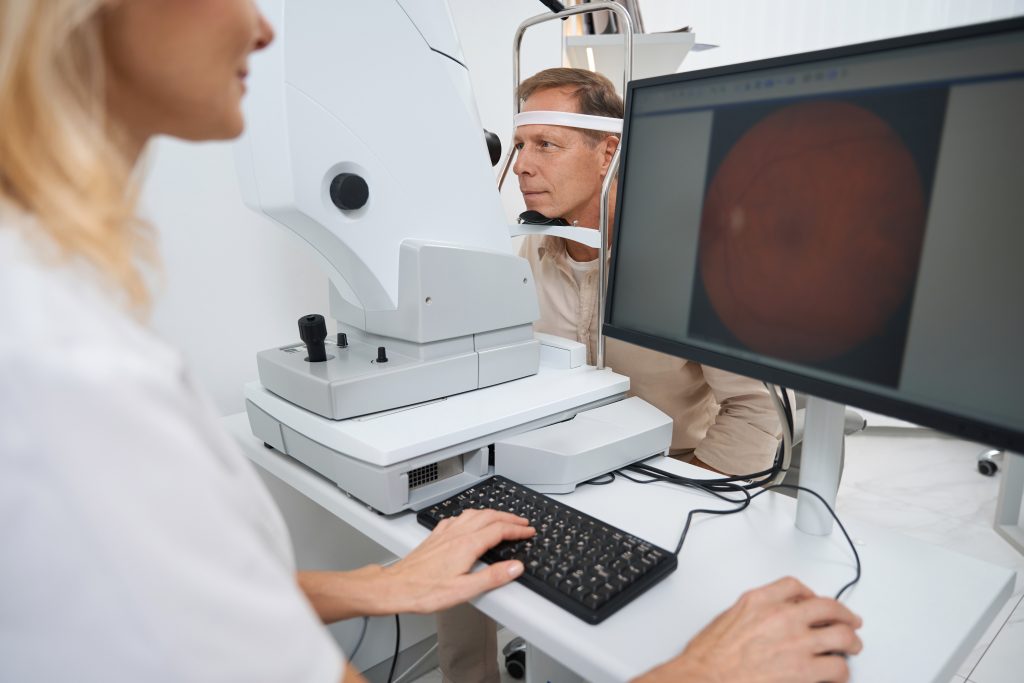February is Low Vision Awareness Month, a time to raise awareness about the challenges faced by individuals with low vision and to highlight the importance of early detection and proper care. Low vision refers to a visual impairment that cannot be corrected by glasses, contact lenses, or surgery, and it can significantly impact a person’s quality of life. At Premium Healthcare, we’re committed to providing expert care and resources to help individuals manage low vision and live their lives to the fullest.
In this blog post, we’ll discuss what low vision is, how it affects daily life, common causes, and the steps you can take to protect your vision and manage vision loss.


1. What is Low Vision?
Low vision is defined as a significant decrease in vision that cannot be corrected with traditional glasses, contact lenses, or surgery. It can affect one or both eyes and often makes everyday tasks, such as reading, driving, or recognizing faces, difficult. Unlike blindness, people with low vision may still have some remaining sight, but it may be blurry, distorted, or impaired.
Tip: If you or a loved one are experiencing difficulties with vision that glasses or surgery can’t improve, it’s important to consult with an eye care professional to determine if low vision is the cause.
2. How Low Vision Affects Daily Life
Living with low vision can be challenging, as it can interfere with basic daily activities and affect overall independence. Some of the ways low vision impacts life include:
- Reading: Difficulty reading books, newspapers, or digital screens can lead to frustration and isolation.
- Driving: Many individuals with low vision are unable to drive, limiting mobility and independence.
- Personal Care: Tasks like grooming, dressing, and cooking may become more difficult due to impaired vision.
- Social Interaction: Low vision can make it hard to recognize faces, follow conversations, or participate in social activities, leading to feelings of loneliness.
- Work and Education: For children and adults alike, low vision can affect academic and work performance, creating barriers to success in school or at the workplace.
Tip: Simple adjustments, such as using larger text on digital devices or employing magnifying tools, can make daily tasks more manageable for individuals with low vision.
3. Common Causes of Low Vision
There are several conditions that can lead to low vision. Some of the most common causes include:
- Age-Related Macular Degeneration (AMD): A condition that affects the central part of the retina (macula), leading to blurred or distorted vision in the center of the visual field.
- Glaucoma: A group of eye diseases that damage the optic nerve, often due to increased intraocular pressure, leading to peripheral vision loss.
- Diabetic Retinopathy: Damage to the blood vessels in the retina due to diabetes, causing vision loss over time.
- Cataracts: Clouding of the lens in the eye, resulting in blurry vision and difficulty seeing in low-light conditions.
- Retinitis Pigmentosa: A genetic disorder that causes gradual vision loss, often starting with peripheral vision and progressing to central vision loss.
Tip: Regular eye exams are crucial for detecting these conditions early and preventing further vision loss. If you have a family history of eye diseases or chronic conditions like diabetes, be sure to talk to your eye doctor about preventive care.
4. Managing Low Vision: Treatment and Support
While there is no cure for most forms of low vision, there are numerous strategies and resources available to help individuals manage their condition and enhance their quality of life. At Premium Healthcare, we offer a range of services and guidance to help those with low vision, including:
1. Vision Rehabilitation
Vision rehabilitation focuses on teaching people with low vision how to adapt to their environment and maintain their independence. It includes training in using adaptive technologies, magnification devices, and techniques to improve day-to-day tasks. Our specialists can guide you through these processes and help you find the tools that work best for your needs.
2. Low Vision Aids and Devices
There are various aids and devices designed to assist people with low vision. These include:
- Magnifying glasses
- Text-to-speech software and screen readers
- Electronic magnifiers
- Smart glasses
- Large-print books and documents Our team at Premium Healthcare can help connect you with these devices and show you how to use them effectively.
3. Regular Eye Care and Monitoring
It’s important to maintain regular checkups with an eye care professional to monitor the progression of low vision and manage any underlying conditions. Early detection and treatment can help preserve remaining vision and prevent further loss.
4. Emotional and Psychological Support
Vision loss can take an emotional toll, and many people with low vision experience feelings of depression or anxiety. Support groups, counseling, and therapy can help individuals cope with the emotional challenges of living with low vision.
5. Tips for Living with Low Vision
There are many ways you can adjust to living with low vision and continue enjoying an active lifestyle. Here are a few helpful tips:
- Create a Well-Lit Environment: Good lighting can make a significant difference in how well you see. Use bright, glare-free lighting in your home and workspace.
- Organize Your Space: Keep your home well-organized, with important items in consistent, easily accessible places. Label things with large print or braille to make them easier to find.
- Use Technology: There are a variety of apps and devices designed to help individuals with low vision. From smartphones with voice command features to specialized apps for navigation, technology can be an invaluable tool.
- Stay Active: Exercise is important for maintaining overall health, including mental well-being. Find activities that are comfortable and accessible, such as walking, swimming, or chair yoga.
Tip: Small changes in your home and routine can help you stay independent and maintain a fulfilling lifestyle, even with low vision.
6. Low Vision Awareness: Why It’s Important
Low Vision Awareness Month is an opportunity to educate the public about the challenges faced by individuals with low vision, reduce stigma, and promote early detection and treatment. It’s also a time to emphasize the importance of vision health, encourage regular eye exams, and provide support to those affected.
At Premium Healthcare, we’re committed to raising awareness about low vision and ensuring that those affected have access to the care and resources they need.


Taking Control of Your Vision Health
Low Vision Awareness Month is an important reminder that vision health should be a priority at every stage of life. If you or someone you love is experiencing vision challenges, don’t wait to seek help. Regular eye exams, early intervention, and the right support can make all the difference in managing low vision.
At Premium Healthcare, we are here to provide the care, resources, and assistance you need to manage low vision and maintain a high quality of life. Our expert team of eye care professionals is ready to help you navigate the path to better vision health.


